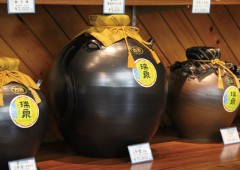2012.10.19
Japan wary as China brings more ships closer to territory
China has a pair of destroyers among a group of warships that have been spotted in waters near Yonaguni Island in southern Okinawa Prefecture, a move that while legal, has Japan concerned.
“A Japanese aircraft spotted seven Chinese naval ships in waters 49 kilometers south-southeast of Yonaguni Island at 7 a.m. Tuesday,” a Defense Ministry spokesman announced. Yonaguni is an inhabited territory internationally acknowledged as Japanese. “They were in contiguous waters, 44 kilometers southwest of Nakanokamishima,” the spokesman added, noting “they were moving north, from the Pacific Ocean to the East China Sea.:
That’s perfectly legal, as contiguous waters lie just outside territorial waters, and are governed by international maritime law. The ministry identified two destroyers, at least one with missile capabilities, two frigates, two submarine rescue ships and one supply ship. “At this time,” says Defense Minister Satoshi Morimoto, “we are not seeing such acts as helicopters flying from these naval ships and approaching toward our nation, or sailing within our territorial waters. We are continuing to be on alert,” he adds, “maintaining surveillance of the area waters with aircraft and ships.
The Defense Minister notes the vessels’ arrival near Okinawa waters comes after days of relative calm in the Senkaku Islands dispute between China and Japan. Since Japan declared sovereignty by purchasing the islands from a Japanese landowner, China’s been agitated and there have been anti-Japanese demonstrations in China, including the burning of Japanese businesses.
There have been a number of Chinese government ships, mostly maritime surveillance ships and fisheries patrol vessels, entering waters close to Japan, but this is the first time Chinese naval ships have ventured close. The way the islands are laid out, there are gaps that allow vessels to stay away from the contiguous zones, which extend a further 12 nautical miles beyond the 12 nautical miles of territorial waters, but under the United Nations Convention of the Law of the Sea, foreign vessels, including military vessels, do have the right to use the contiguous zone. Both Japan and China are signatories to the U.N. law. At the same time, there are technicalities in the law that grant states the right to “prevent infringement of its customs, fiscal, immigration or sanitary laws and regulations within its territory or territorial seas.” That has officials pondering the next Japanese response.
As the tense situation continues, Japan’s Foreign Minister, Koichiro Genba, has turned to visiting U.S. Deputy Secretary of State William Burns and asked for American support for Japan’s position on the Senkaku islands. “I look forward to having a fruitful discussion on the Japan-U.S. bilateral relationship,” Genba told Burns at the start of the talks, “including the security arrangements and also the current increasingly severe situation in East Asia.” Burns says he’ll be happy to reaffirm the importance of the relationship and partnership with Japan.

 2024.07.07
2024.07.07 2024.06.21
2024.06.21 2024.05.15
2024.05.15 2024.02.07
2024.02.07 2024.01.31
2024.01.31 2023.11.02
2023.11.02 2023.10.26
2023.10.26 2023.09.29
2023.09.29 2023.09.01
2023.09.01






